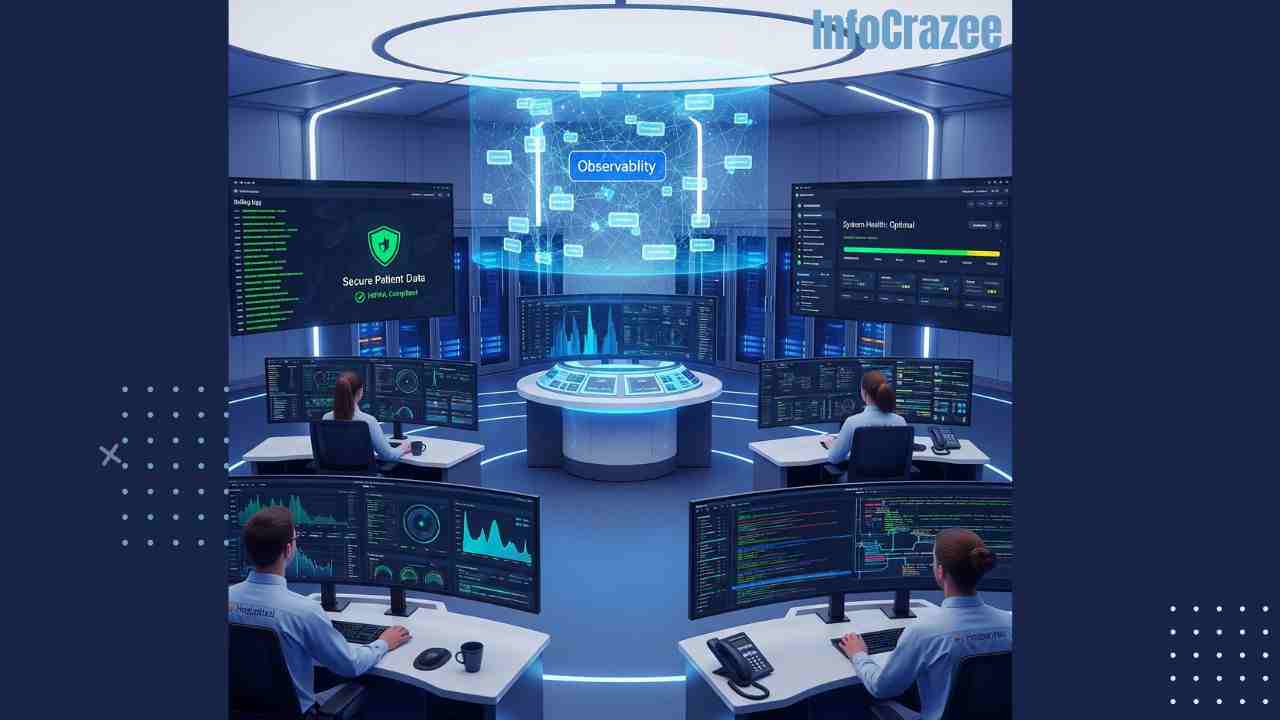How Observability Enhances IT and Security Operations in Healthcare
In the fast-evolving healthcare landscape of 2025, where digital transformation and cybersecurity are critical, observability has emerged as a cornerstone for optimizing IT and security operations. Observability goes beyond traditional monitoring, providing comprehensive insights into complex systems by leveraging telemetry data—logs, metrics, and traces. This capability is transforming how healthcare organizations manage their IT infrastructure, ensure compliance, and safeguard patient data. Below, we explore how observability enhances IT and security operations in healthcare and why it’s indispensable in today’s environment.
What is Observability in Healthcare?
Observability is the ability to understand the internal state of a system by analyzing its external outputs. In healthcare, this means gaining real-time visibility into IT systems, applications, and security environments that power electronic health records (EHRs), telehealth platforms, medical devices, and cloud-based services. Unlike traditional monitoring, which focuses on predefined metrics, observability enables proactive detection and resolution of issues across distributed, interconnected systems.
Key Benefits for IT Operations
1. Proactive Issue Detection and Resolution
Healthcare IT systems, such as EHR platforms and telehealth applications, must operate seamlessly to ensure uninterrupted patient care. Observability tools like Datadog, New Relic, or open-source solutions (e.g., Prometheus) collect and correlate telemetry data to identify anomalies before they escalate. For example:
- Real-Time Performance Insights: Observability detects latency in EHR systems, enabling IT teams to resolve bottlenecks before they disrupt clinical workflows.
- Root Cause Analysis: By analyzing logs and traces, IT teams can pinpoint the cause of system failures, such as a misconfigured API in a telehealth platform, reducing downtime.
2. Optimizing Cloud and Hybrid Environments
Healthcare organizations increasingly rely on hybrid and multi-cloud environments to support scalable services like remote patient monitoring and AI-driven diagnostics. Observability provides:
- Unified Visibility: Tools aggregate data across on-premises servers, cloud platforms (e.g., AWS, Azure), and IoT devices, ensuring holistic oversight.
- Cost Efficiency: By identifying underutilized resources, observability helps optimize cloud spending, a critical factor given rising operational costs in 2025.
3. Improved Patient Experience
Downtime or slow performance in healthcare applications can compromise patient care. Observability ensures high availability of critical systems, such as:
- Telehealth Platforms: Monitoring user experience metrics ensures seamless virtual consultations.
- Medical IoT Devices: Observability tracks device performance, ensuring accurate data collection for wearables or connected diagnostic tools.
Enhancing Security Operations
1. Real-Time Threat Detection
With cyberattacks on healthcare organizations surging—ransomware attacks rose 27% from 2023 to 2024—observability strengthens security operations by:
- Anomaly Detection: Machine learning-driven observability platforms, like Splunk or Elastic, identify unusual patterns in network traffic, such as unauthorized access to patient data.
- Incident Correlation: By correlating logs from firewalls, EHR systems, and endpoints, observability helps security teams detect sophisticated threats like lateral movement in real time.
2. Compliance with Regulatory Standards
Healthcare organizations must comply with stringent regulations like HIPAA and GDPR. Observability supports compliance by:
- Audit Trails: Comprehensive logging ensures all access to patient data is traceable, simplifying audits.
- Data Integrity Monitoring: Observability tools detect unauthorized changes to sensitive data, ensuring compliance with data protection standards.
3. Faster Incident Response
When a security breach occurs, every second counts. Observability accelerates incident response by:
- Automated Alerts: Security Information and Event Management (SIEM) systems integrated with observability platforms send real-time alerts for suspicious activities.
- Forensic Analysis: Detailed traces enable security teams to reconstruct attack timelines, identifying vulnerabilities and preventing future incidents.
Real-World Impact in 2025
- Case Study: Cleveland Clinic: By adopting an observability platform in 2024, Cleveland Clinic reduced IT incident resolution time by 40%, ensuring uninterrupted access to EHRs during peak demand.
- Ransomware Mitigation: A mid-sized hospital used observability tools to detect and isolate a ransomware attack in early 2025, preventing data loss and minimizing downtime.
- Telehealth Scalability: A telehealth provider leveraged observability to monitor application performance, handling a 30% surge in virtual visits during flu season without service degradation.
Challenges and Considerations
While observability offers immense benefits, healthcare organizations must address:
- Data Overload: Managing high volumes of telemetry data requires robust storage and analytics solutions.
- Integration Complexity: Ensuring observability tools work across legacy and modern systems demands careful planning.
- Cost Management: Subscription-based observability platforms can be expensive, necessitating a clear ROI strategy.
The Future of Observability in Healthcare
In 2025, observability is evolving with advancements in AI and automation. Predictive analytics, powered by machine learning, will enable IT and security teams to anticipate issues before they occur. Additionally, observability platforms are integrating with AI-driven healthcare tools, such as diagnostic algorithms, to provide end-to-end visibility from patient care to infrastructure performance.
Conclusion
Observability is no longer optional—it’s a strategic necessity for healthcare organizations aiming to deliver reliable, secure, and patient-centric services. By providing real-time insights, accelerating incident response, and ensuring compliance, observability empowers IT and security teams to navigate the complexities of modern healthcare systems. As the industry continues to embrace digital transformation, investing in robust observability solutions will be critical to staying ahead in 2025 and beyond.

![Write page title Page titles should be around 580 pixels in length. Or meta description Meta descriptions should be around 920 pixels in length. On[ Healthcare Mergers and Acquisitions: Key Highlights from 2025 ] that is clear, simple, and engaging, using a friendly and conversational tone. Avoid generic or overly formal words like "delve," "comprehensive," or "leverage." Instead, use natural language that feels human and relatable. Structure the content with headings, subheadings, and bullet points to make it easy to scan and read.please give me Focus keyphrase.](https://infocrazee.com/wp-content/uploads/2025/08/wfucgw-dpcsjx-7-768x432.jpg)